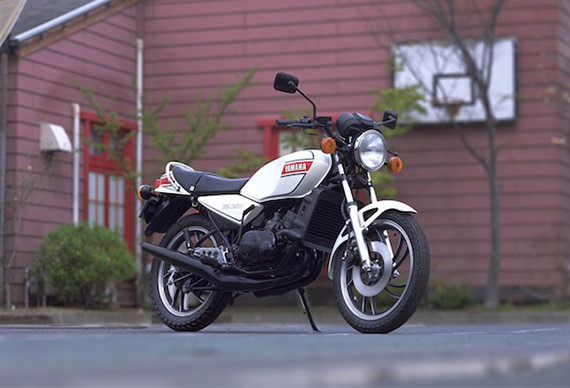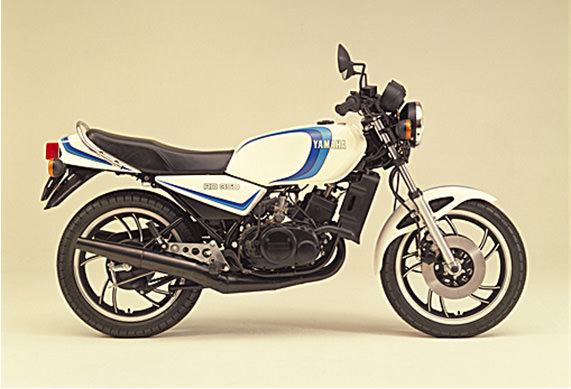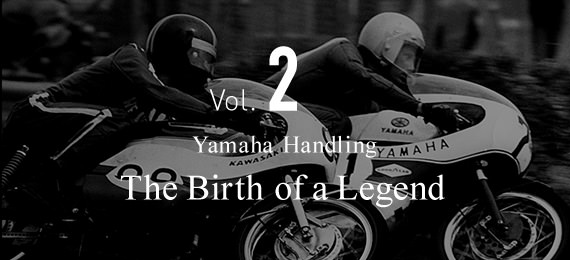Vol.5 A Supersports Milestone: The TZR250 Yamaha’s Racing DNA Embodied
Entering the 1980s, Yamaha not only succeeded in recovering its reputation for the excellence of Yamaha Handling with the masterpieces of its 4-stroke, 4-cylinder XJ Series but also quickly showed renewed vigor by reviving the 2-stroke supersport bike category with models like the RZ250 at a time when the need to clear emissions and noise standards had even brought forth talk that 2-stokes had no future as power units for supersport models. The success of the RZ250 prompted Yamaha’s competitors to launch a number of 2-stroke “racer replica” models, but Yamaha responded by releasing the TZR250, a model that remains a symbol of Yamaha Handling. One of the defining characteristics of the TZR250 was that it was developed by Yamaha’s proud team of race machine engineers, and knowhow directly from the latest factory machines of the time was implemented in its design.
The 500cc class GP machines were especially difficult to achieve the right combination of high power and handling, and the development theme for the YZR500 had already entered the same realm of “achieving a balance in tune with rider perceptions” that Yamaha engineers continue to strive for today. The ideal of valuing the basic characteristics of the model’s engine and handling in order to achieve a smooth, easy-to-use character for both was applied to the TZR models just as it was for the YZR.
*The article below is a translation of a RIDERS CLUB article originally published in 1996 and contains additions and revisions.
Ken Nemoto
Born in Tokyo, Japan in 1948.
Withdrew from Keio University's Faculty of Letters.
He began riding motorcycles at age 16, won the 750cc All Japan Road Race Championship title in 1973 and competed in the World GP from 1975 to 1978. After returning to Japan, he served as the editor in chief of RIDERS CLUB magazine for 17 years and also served in producing a wide variety of hobbyist magazines. Today, he competes in the AHRMA's classic motorcycle races at Daytona Speedway as part of his life work.
Reviving the 2-stroke Supersport Category with the RZ250
Now that Yamaha had finally switched to a 4-cylinder engine like its rivals, it was not only quick to catch up in the 4-stroke supersport category but soon went on to the next level of product excellence and quickly began leading the industry thanks to the famous XJ650 and XJ400 models. In 1980, the year that these two models were launched, Yamaha also released a 2-stroke model that would go down in industry history as an epoch-making machine—the RZ250.
The RZ250 could be called the equivalent of a statement by Yamaha: the 2-stroke supersport was back and wasn’t going to become a victim of the new era of emissions regulations and other factors as some were predicting. The reason the RZ250 was considered as such was Yamaha’s RD400 released in 1976. The RD400 didn’t have the aggressive character and feel that was a fundamental appeal of 2-strokes, and its performance was thought to have been muted in an attempt to imitate the milder engine character of 4-strokes. It was then that we began to hear murmurs about the demise of the 2-stroke.
However, at the same time, the TZ250, TZ350 and TZ750 production racers and the YZR500 factory machine that symbolized Yamaha continued to be top performers in the race arena. For fans that originally knew Yamaha as a 2-stroke manufacturer, many were unquestionably hoping for production models that were the embodiment of that racing image. Yamaha was also eager to respond to those expectations as best it could and keep the 2-stroke era alive. So, the decision was made to develop a new 2-stroke supersport model with the same liquid-cooled engine used on its race machines.
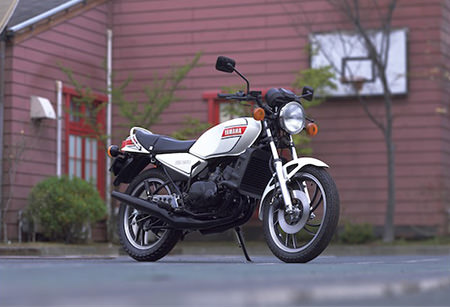
RZ250
The “pure sports” model RZ250 had a 2-stroke’s inherent light weight and sharp feeling of acceleration, and offered light, agile handling performance. Together with its stylish design, it was a big hit with customers. Its success helped revive the faltering popularity of 2-stroke models
(Released in 1980)
The results of this project soon debuted as the RD350LC for export to overseas markets and the RZ250 for the Japanese market. Particularly in Japan, which was in the midst of a motorcycling boom, the RZ250’s image as “the TZ racer replica” made it a big hit. Designed and engineered to have true 2-stroke character typified by sharp response in the peak range and a torquey feeling in the mid-range, many motorcycle fans were enamored with it. Spurred by this model’s success, Yamaha’s rival manufacturers developed and released their own 2-stroke 250cc racer replica models one after another, bringing Japan’s motorcycle industry into what would eventually be called “the replica era.”
Of course, part of the RZ250’s high acclaim was derived from its handling. In what was a typically Yamaha package, it had light and sharp handling built on a solid base of easy-to-use machine stability. For Yamaha, with its experience in developing the TZ250 and TZ350 production racers that proved so dominant on the racetrack, there were no technological difficulties with the adoption of a single-shock Monocross suspension for the rear, chassis rigidity and the like. Yamaha was so particular about the high level of perfection in the RZ250 that—if deemed necessary—it would further fine-tune the performance and feeling in the practical-use range to create a certain feeling for the rider. As Yamaha was very successful with the XJ Series models thanks to this kind of handling that any rider could enjoy, it was also a time when the Yamaha Handling image was becoming widely recognized and common motorcycling knowledge. However, the real fight to cement this reputation was actually yet to come.
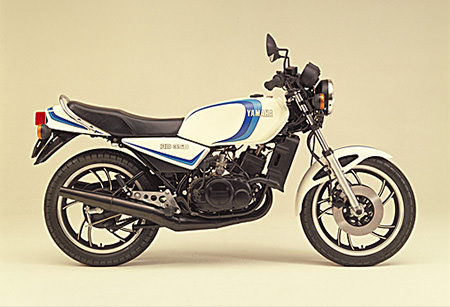
RZ350
The 350cc RD350LC model released in Europe inspired a boom in one-make races and almost immediately became a massive hit
Entering a New Realm of Handling: “Rider Perceptions” as the Defining Theme
Having revived the 2-stroke supersport category with its RZ Series, Yamaha raised the bar once again with the introduction of the 4-cylinder RZV500R model [RD500LC for overseas markets] in 1984. However, the appearance of the TZR250 with its aluminum Deltabox frame in 1985 can’t be spoken of simply as a byproduct of the racer replica boom, and has to be described as a unique and exceptional development. This is because it went far beyond just the next evolution of the 2-stroke supersport to become an important model that would heavily influence the direction of state-of-the-art supersport handling as well as the future of 4-stroke big-bikes.
The big difference that separated the TZR250 development project from that of any other Yamaha models to date was that the factory race machine engineers at the time were brought in to work directly on the model. The Project Leader, Teruo Abe
(a member of Yamaha’s 2nd Project Engineering Division at the time), made the decision to have production model developers become members of the Racing Group he belonged to.
This resulted in the TZR250 using the aluminum Deltabox frame that had just recently been adopted on the YZR500 at the time, which essentially made it a YZR replica. However, the reason that this model deserves special mention is not because of how closely it resembled the YZR500.
It was the fact that the handling of the TZR250 was developed with the same approach as the YZR500. In order to explain why this was important, I first of all have to go back a few steps and talk about the path that the YZR500’s development had taken up to that point.
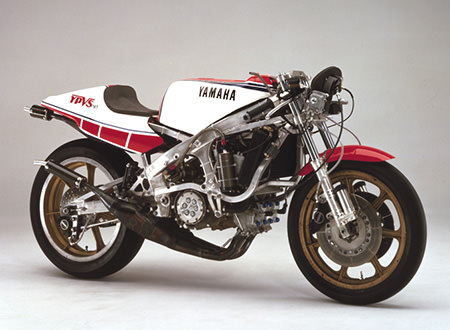
1982 YZR500 (0W61)
This was the first GP500 machine with a 2-stroke V4 engine. It had an advanced aluminum frame and featured many unique components like the rear suspension located under the chassis and positioned laterally instead of longitudinally. It was also the base model for developing the RZV500R production supersport model
Like the other Japanese manufacturers, Yamaha had to withdraw its multi-cylinder, multi-geared factory machines from GP competition in the 1960s, but Yamaha alone remained involved in racing into the 1970s by supplying production racers. The company would finally make a full-fledged return to the World GP by making its first entry in the 500cc class with the YZR500 in 1973.
The first YZR500, codenamed 0W20, adopted a unique engine format that connected two in-line twin engine blocks side-by-side to form an in-line 4-cylinder engine. The reason behind this format was to make use of Yamaha’s proven 250cc in-line twin engine, while also opening up the possibility of feeding knowhow directly back into production model development. This same method was used later in developing the TZ750 by connecting two TZ350 engine blocks together.
However, this in-line 4-cylinder format naturally made the machine wider. From 1981 and onward, the appearance of the Suzuki RG500Γ, with its slim and compact square-four engine, and the light and agile handling 3-cylinder Honda NS500, meant that the Yamaha in-line four could no longer match its rivals, even with the skills of legendary rider Kenny Roberts. Yamaha responded in 1981 and 1982 by developing a square-four and then a V4 engine in an attempt to quickly catch and overtake its rivals. However, these attempts ran into major setbacks.
The story is also a historically valuable tale that the development engineers chose to reveal regarding what took place during their factory machine development when we interviewed them for a RIDERS CLUB feature article on the YZR500. It was about what happened during the development of the 0W61 codenamed factory machine. The engineers attempted to develop a more compact engine, first by linking two 250cc in-line twin engine blocks front and rear to create a square-four, and then by linking them top and bottom to form a V4 engine.
This 0W61 was a machine for which Yamaha sought to include every specification thought to be advantageous at the time.
It was developed based on input from their rider at the time, racing genius “King” Kenny Roberts. One example of Roberts’ requests was to make the rear tire as wide as possible, and it led Yamaha to work with its tire supplier to develop an extra-wide race tire. For King Kenny, one of the few riders who could fully handle the increasingly powerful 500cc racers of the day, he most likely thought that as long as the tires had fantastic grip, he could apply more power while cornering.
He also probably felt that despite the high power the machine had finally achieved—and he was confident he could handle—it’d actually go to waste because the rear tire would start to slip.
However, this was before the invention of the radial tires we use today that provide light, agile handling even when widened.
The extremely wide bias tire that they developed at Kenny’s request was coupled with an extremely wide wheel rim, and this combination made getting the machine to lean into a turn very slow and heavy because of the added width of the tread surface area that came into play. This produced handling that made the bike difficult to ride, even for King Kenny.
Also, with regard to the engine character, Kenny was very comfortable handling the powerful 500cc machines. He believed that instead of relying on the bike’s mid-range character in the corners like other riders, he could run through the corners keeping it in the peak range, so he wanted a more powerful engine, even if that meant it was more peaky in character.
The engineers said that they gave him the kind of engine he asked for. However, once the race season started, the combination of this engine performance and the new wide tire meant even Kenny had to use the mid-range through the corners much of the time. The result was that even though he was fastest on the straights, he would actually lose time because of the slower corner exit acceleration.
Furthermore, with regard to chassis rigidity, in order to take on the challenge of the high speeds of Daytona with the square-four engine spec, a cross member was added to the frame to make an extremely rigid chassis in anticipation of the high loads it would be subjected to in the high-speed turns.
However, that added rigidity made the machine so stiff that it couldn’t be maneuvered effectively through the chicane. Forced to deal with this unexpected result, the team had to quickly cut out the cross member right there at the track.
The development team’s attempt to meet all of the requests of this great rider—who could do things others couldn’t even imagine—led to trying things that went beyond the common sense engineering of the day, but was infeasible in the end.
Pursuing basic machine characteristics that feel in tune with rider perceptions
After this valuable experience, the engineers developing Yamaha’s factory machines devoted themselves to the principle that “every characteristic of the machine must feel natural and in tune with rider perceptions.”
For the engine character of the next model they developed, the 0W70, instead of a blind pursuit of peak power, they began by seeking a character that would provide a smooth, steady building of power from mid-range speeds, even though it meant sacrificing some peak range power. With regard to the chassis, they sought a high level of rigidity while keeping the right amount of flexibility. In ways such as these, the development involved themes that were not very different from those of a regular road-going sports bike.
For the frame in particular, they worked from their base of knowhow concerning the structural shapes that provided good strength when using conventional squared aluminum pipes. To create a frame that had the right amount of flexibility when stress was applied, the structure was constructed of aluminum plates instead of pipes and the resulting Deltabox frame was adopted for the first time.
(Continue to Part 2)

Teruo Abe, the Project Leader for developing the TZR250
(member of Yamaha’s 2nd Project Engineering Division in 1996)



